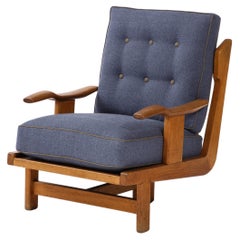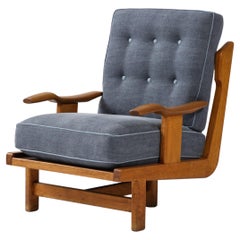Guillerme Et Chambron Tripod
Recent Sales
Mid-20th Century French Mid-Century Modern Armchairs
Linen, Oak
Mid-20th Century French Mid-Century Modern Armchairs
Linen, Oak
Vintage 1960s French Mid-Century Modern Dining Room Chairs
Oak
20th Century French Mid-Century Modern Lounge Chairs
Fabric, Wood
Vintage 1960s French Mid-Century Modern Dining Room Chairs
Onyx, Alabaster
Vintage 1950s French Mid-Century Modern Side Chairs
Fabric, Oak
Vintage 1970s French Mid-Century Modern Side Chairs
Upholstery, Oak
Vintage 1950s French Mid-Century Modern Side Chairs
Oak
Guillerme et Chambron for sale on 1stDibs
Robert Guillerme and Jacques Chambron, the French creative duo behind Votre Maison, met under unusual circumstances: They discussed design while imprisoned in a forced labor camp. The pair’s combined talents later resulted in modern, sculptural furniture — today, vintage Guillerme et Chambron desks, dining tables, chairs and other pieces still look conceptually playful and vibrant but could fit harmoniously into any home.
Guillerme had graduated from the École Boulle in 1934 with a degree in design and architecture, and Chambron had studied at the School of Applied Arts in Reims. They were captured by the Germans in East Prussia during the Second World War and struck up a friendship over their mutual love for all things design.
After the war ended, Guillerme moved to Lille in northern France; Chambron left his job as a painter and decorator in Paris and joined him in 1948. In 1949, the pair met Émile Dariosecq, a skilled cabinetmaker who enthusiastically agreed to manufacture the duo’s designs, leading to the start of Votre Maison.
Guillerme and Chambron were as prolific as they were detailed, producing more than 2,000 pieces in the second half of the 20th century out of a former gun factory. Their furniture, which was mostly made with different tones of waxed oak, adhered to the trends of design that emerged after the war: mid-century modernism.
European furniture in the postwar period largely prioritized function as much as it did form and lacked any unnecessary ornamentation. Guillerme and Chambron wanted people to actually use their furniture, not just look at it. That design philosophy was a pillar of their company, its name translating to “your house” in French. Their signature touches included ornate tiles, hidden drawers and vibrant textiles on pieces such as desks, tables, shelving, lighting, benches and other seating. One of Votre Maison’s most famous and popular pieces was the Grand Repos armchair, a stately, high-backed wide piece with a skeletal oak frame, six spindles and plush cushions.
While Guillerme and Chambron were a team, they handled different aspects of the business: Guillerme designed much of the furniture and Chambron concentrated on decor. Votre Maison was a full-service design business. In 1983, the dynamic duo passed on their company to Chambron’s son, Hervé, a designer and graduate of École Boulle.
Find a collection of vintage Guillerme et Chambron furniture on 1stDibs.
A Close Look at Mid-century-modern Furniture
Organically shaped, clean-lined and elegantly simple are three terms that well describe vintage mid-century modern furniture. The style, which emerged primarily in the years following World War II, is characterized by pieces that were conceived and made in an energetic, optimistic spirit by creators who believed that good design was an essential part of good living.
ORIGINS OF MID-CENTURY MODERN FURNITURE DESIGN
- Emerged during the mid-20th century
- Informed by European modernism, Bauhaus, International style, Scandinavian modernism and Frank Lloyd Wright’s architecture
- A heyday of innovation in postwar America
- Experimentation with new ideas, new materials and new forms flourished in Scandinavia, Italy, the former Czechoslovakia and elsewhere in Europe
CHARACTERISTICS OF MID-CENTURY MODERN FURNITURE DESIGN
- Simplicity, organic forms, clean lines
- A blend of neutral and bold Pop art colors
- Use of natural and man-made materials — alluring woods such as teak, rosewood and oak; steel, fiberglass and molded plywood
- Light-filled spaces with colorful upholstery
- Glass walls and an emphasis on the outdoors
- Promotion of functionality
MID-CENTURY MODERN FURNITURE DESIGNERS TO KNOW
- Charles and Ray Eames
- Eero Saarinen
- Milo Baughman
- Florence Knoll
- Harry Bertoia
- Isamu Noguchi
- George Nelson
- Danish modernists Hans Wegner and Arne Jacobsen, whose emphasis on natural materials and craftsmanship influenced American designers and vice versa
ICONIC MID-CENTURY MODERN FURNITURE DESIGNS
- Eames lounge chair
- Nelson daybed
- Florence Knoll sofa
- Egg chair
- Womb chair
- Noguchi coffee table
- Barcelona chair
VINTAGE MID-CENTURY MODERN FURNITURE ON 1STDIBS
The mid-century modern era saw leagues of postwar American architects and designers animated by new ideas and new technology. The lean, functionalist International-style architecture of Le Corbusier and Bauhaus eminences Ludwig Mies van der Rohe and Walter Gropius had been promoted in the United States during the 1930s by Philip Johnson and others. New building techniques, such as “post-and-beam” construction, allowed the International-style schemes to be realized on a small scale in open-plan houses with long walls of glass.
Materials developed for wartime use became available for domestic goods and were incorporated into mid-century modern furniture designs. Charles and Ray Eames and Eero Saarinen, who had experimented extensively with molded plywood, eagerly embraced fiberglass for pieces such as the La Chaise and the Womb chair, respectively.
Architect, writer and designer George Nelson created with his team shades for the Bubble lamp using a new translucent polymer skin and, as design director at Herman Miller, recruited the Eameses, Alexander Girard and others for projects at the legendary Michigan furniture manufacturer.
Harry Bertoia and Isamu Noguchi devised chairs and tables built of wire mesh and wire struts. Materials were repurposed too: The Danish-born designer Jens Risom created a line of chairs using surplus parachute straps for webbed seats and backrests.
The Risom lounge chair was among the first pieces of furniture commissioned and produced by celebrated manufacturer Knoll, a chief influencer in the rise of modern design in the United States, thanks to the work of Florence Knoll, the pioneering architect and designer who made the firm a leader in its field. The seating that Knoll created for office spaces — as well as pieces designed by Florence initially for commercial clients — soon became desirable for the home.
As the demand for casual, uncluttered furnishings grew, more mid-century furniture designers caught the spirit.
Classically oriented creators such as Edward Wormley, house designer for Dunbar Inc., offered such pieces as the sinuous Listen to Me chaise; the British expatriate T.H. Robsjohn-Gibbings switched gears, creating items such as the tiered, biomorphic Mesa table. There were Young Turks such as Paul McCobb, who designed holistic groups of sleek, blond wood furniture, and Milo Baughman, who espoused a West Coast aesthetic in minimalist teak dining tables and lushly upholstered chairs and sofas with angular steel frames.
Generations turn over, and mid-century modern remains arguably the most popular style going. As the collection of vintage mid-century modern chairs, dressers, coffee tables and other furniture for the living room, dining room, bedroom and elsewhere on 1stDibs demonstrates, this period saw one of the most delightful and dramatic flowerings of creativity in design history.

